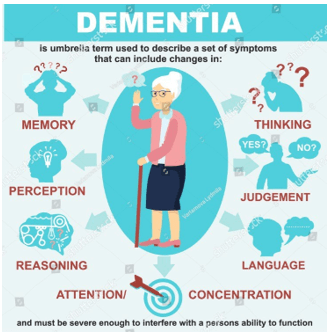A nurse is caring for a client who has dementia.
Which of the following findings should the nurse expect?
Memory loss that disrupts ADLs
Catatonia
Illusions
Pressured speech
The Correct Answer is A
a. Memory loss that disrupts ADLs
Explanation: Dementia is a condition characterized by a decline in cognitive function that affects a person's ability to perform activities of daily living (ADLs). Memory loss is a common symptom of dementia, particularly in the early stages. The memory loss can disrupt a person's ability to carry out tasks they were previously able to do independently, such as dressing, bathing, and eating. Therefore, option a is the correct answer.
Option b, catatonia, is a condition characterized by a lack of movement or activity, which is not typically associated with dementia.
Option c, illusions, involve a misinterpretation of sensory information and may occur in some forms of dementia but are not a defining feature.
Option d, pressured speech, is a symptom commonly associated with mania or bipolar disorder, but is not typically seen in dementia.

Nursing Test Bank
Naxlex Comprehensive Predictor Exams
Related Questions
Correct Answer is B
Explanation
An incident report is formal documentation used to report any unexpected or adverse events that occur during the course of patient care. It provides a record of the incident and helps identify areas for improvement in patient safety and quality of care. The incident report should include details about the error, the potential impact on the client, actions taken to address the error, and any necessary follow-up.
A nursing care plan is a document that outlines the client's nursing diagnoses, goals, interventions, and evaluations. It is not the appropriate place to document a medication error or incident.
The provider's progress notes are documentation made by the healthcare provider, typically documenting their assessments, diagnoses, treatment plans, and progress of the client. A medication error made by the nurse should not be documented in the provider's progress notes.
The controlled substance inventory record is a record used to track the dispensing and administration of controlled substances. While it is important to maintain accurate records of controlled substances, documenting a medication error in this record is not the appropriate place as it is primarily used for inventory management purposes
Correct Answer is B
Explanation
Stomatitis is an inflammation of the oral mucosa, which can cause pain, discomfort, and difficulty eating. To manage stomatitis, clients should consume soft, bland foods that are easy to chew and swallow, such as cooked vegetables, mashed potatoes, and oatmeal.
Acidic, spicy, or crunchy foods should be avoided. Using lemon glycerin swabs can irritate the oral mucosa, so they should not be used.
Mouthwashes containing alcohol can cause further irritation, so they should also be avoided. Eating foods high in vitamin B12 can be helpful for preventing stomatitis, but it is not an appropriate intervention for managing an existing case of stomatitis.
Whether you are a student looking to ace your exams or a practicing nurse seeking to enhance your expertise , our nursing education contents will empower you with the confidence and competence to make a difference in the lives of patients and become a respected leader in the healthcare field.
Visit Naxlex, invest in your future and unlock endless possibilities with our unparalleled nursing education contents today
Report Wrong Answer on the Current Question
Do you disagree with the answer? If yes, what is your expected answer? Explain.
Kindly be descriptive with the issue you are facing.
